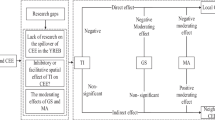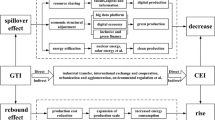Abstract
Carbon emission efficiency directly determines the level of green economic development. Based on the panel data of China’s Yangtze River Economic Belt (YEB) from 2008 to 2017, this paper uses the stochastic frontier analysis (SFA) model to analyze the overall carbon emission efficiency level, influencing factors, and changing trends, with a view to discussing the relationship between economic development and carbon emission efficiency. The results suggest, first, the overall carbon emission efficiency of the YEB is on an upward trend, but there is still much room for improvement. Second, the impact of industrialization and urbanization on carbon emission efficiency follows a U-shaped. As industrialization and urbanization progress, the impact on carbon emission efficiency shows a downward and then upward trend. Third, due to the rebound effect, technological progress has a slight negative impact on carbon emission efficiency. Energy consumption structure, government intervention, and foreign trade are all negative incentive factors. Therefore, efforts to improve carbon emission efficiency in the YEB should focus on transforming the economic growth model, adjusting the industrial structure, improving the energy consumption structure, and innovating green technology. The research results can provide a reference for the government policymakers to develop a green economy.








Similar content being viewed by others
Data availability
All data are from the China statistical yearbook.
Notes
In China, provinces and municipalities are all provincial-level administrative regions, so all use “province” in this paper.
References
Abdallh AA, Abugamos H (2017) A semi-parametric panel data analysis on the urbanisation-carbon emissions nexus for the MENA countries. Renew Sust Energ Rev 78:1350–1356. https://doi.org/10.1016/j.rser.2017.05.006
Aigner D, Lovell CAK, Schmidt P (1977) Formulation and estimation of stochastic frontier production function models. J Econ 6:21–37. https://doi.org/10.1016/0304-4076(77)90052-5
Ali R, Bakhsh K, Yasin MA (2019) Impact of urbanization on CO2 emissions in emerging economy: Evidence from Pakistan. Sustain Cities Soc 48:101553. https://doi.org/10.1016/j.scs.2019.101553
Battese GE, Coelli TJ (1992) Frontier production functions, technical efficiency and panel data: With application to paddy farmers in India. J Prod Anal 3:153–169. https://doi.org/10.1007/BF00158774
Battese GE, Coelli TJ (1995) A model for technical inefficiency effects in a stochastic frontier production function for panel data. Empir Econ 20:325–332. https://doi.org/10.1007/BF01205442
Cai B, Guo H, Ma Z, Wang Z, Dhakal S, Cao L (2019) Benchmarking carbon emissions efficiency in Chinese cities: A comparative study based on high-resolution gridded data. Appl Energy 242:994–1009. https://doi.org/10.1016/j.apenergy.2019.03.146
Chen J, Wang L, Li Y (2020) Research on the impact of multi-dimensional urbanization on China’s carbon emissions under the background of COP21. J Environ Manag 273:111123. https://doi.org/10.1016/j.jenvman.2020.111123
Chen J, Lian X, Su H, Zhang Z, Ma X, Chang B (2021) Analysis of China’s carbon emission driving factors based on the perspective of eight major economic regions. Environ Sci Pollut Res 28:8181–8204. https://doi.org/10.1007/s11356-020-11044-z
Cui H, Wang H, Zhao Q (2019) Which factors stimulate industrial green total factor productivity growth rate in China? An industrial aspect. Greenh Gases Sci Technol 9:505–518. https://doi.org/10.1002/ghg.1874
Du H, Chen Z, Mao G, Li RYM, Chai L (2018) A spatio-temporal analysis of low carbon development in China’s 30 provinces: A perspective on the maximum flux principle. Ecol Indic 90:54–64. https://doi.org/10.1016/j.ecolind.2018.02.044
Erdoğan S, Yıldırım S, Yıldırım DÇ, Gedikli A (2020) The effects of innovation on sectoral carbon emissions: Evidence from G20 countries. J Environ Manag 267:1–10. https://doi.org/10.1016/j.jenvman.2020.110637
Fang K, Tang Y, Zhang Q, Song J, Wen Q, Sun H, Ji C (2019) Will China peak its energy-related carbon emissions by 2030 ? Lessons from 30 Chinese provinces. Appl Energy 255:113852. https://doi.org/10.1016/j.apenergy.2019.113852
Huang Z, Du X (2020) Toward green development ? Impact of the carbon emissions trading system on local governments ’ land supply in energy-intensive industries in China. Sci Total Environ 738:139769. https://doi.org/10.1016/j.scitotenv.2020.139769
Huang J, Chen X, Yu K, Cai X (2020) Effect of technological progress on carbon emissions: New evidence from a decomposition and spatiotemporal perspective in China. J Environ Manag 274:110953. https://doi.org/10.1016/j.jenvman.2020.110953
Huo T, Li X, Cai W, Zuo J, Jia F, Wei H (2020) Exploring the impact of urbanization on urban building carbon emissions in China: Evidence from a provincial panel data model. Sustain Cities Soc 56:102068. https://doi.org/10.1016/j.scs.2020.102068
IPCC 2006. 2006 IPCC Guidelines for National Greenhouse Gas Inventories. https://www .ipcc.ch/report/2006-ipcc-guidelines-for-national-greenhouse-gas-inventories/.
Li J, Cheng Z (2020) Study on total-factor carbon emission efficiency of China’s manufacturing industry when considering technology heterogeneity. J Clean Prod 260:121021. https://doi.org/10.1016/j.jclepro.2020.121021
Li H, Mu H, Zhang M, Gui S (2012) Analysis of regional difference on impact factors of China’s energy - Related CO2 emissions. Energy 39:319–326. https://doi.org/10.1016/j.energy.2012.01.008
Li J, Huang X, Kwan MP, Yang H, Chuai X (2018) The effect of urbanization on carbon dioxide emissions efficiency in the Yangtze River Delta. China J Clean Prod 188:38–48. https://doi.org/10.1016/j.jclepro.2018.03.198
Lin B, Li Z (2020) Spatial analysis of mainland cities’ carbon emissions of and around Guangdong-Hong Kong-Macao Greater Bay area. Sustain Cities Soc 61:102299. https://doi.org/10.1016/j.scs.2020.102299
Lin B, Omoju OE, Okonkwo JU (2015) Impact of industrialisation on CO2 emissions in Nigeria. Renew Sust Energ Rev 52:1228–1239. https://doi.org/10.1016/j.rser.2015.07.164
Liu X, Bae J (2018) Urbanization and industrialization impact of CO2 emissions in China. J Clean Prod 172:178–186. https://doi.org/10.1016/j.jclepro.2017.10.156
Long R, Shao T, Chen H (2016) Spatial econometric analysis of China ’ s province-level industrial carbon productivity and its influencing factors. Appl Energy 166:210–219. https://doi.org/10.1016/j.apenergy.2015.09.100
Meeusen W, van Den Broeck J (1977) Efficiency Estimation from Cobb-Douglas Production Functions with Composed Error. Int Econ Rev (Philadelphia) 18:435. https://doi.org/10.2307/2525757
Meng F, Su B, Thomson E, Zhou D, Zhou P (2016) Measuring China’s regional energy and carbon emission efficiency with DEA models: A survey. Appl Energy 183:1–21. https://doi.org/10.1016/j.apenergy.2016.08.158
Mohsin M, Rasheed AK, Sun H, Zhang J, Iram R, Iqbal N, Abbas Q (2019) Developing low carbon economies: An aggregated composite index based on carbon emissions. Sustain Energy Technol Assessments 35:365–374. https://doi.org/10.1016/j.seta.2019.08.003
Moutinho V, Madaleno M, Macedo P (2020) The effect of urban air pollutants in Germany: eco-efficiency analysis through fractional regression models applied after DEA and SFA efficiency predictions. Sustain Cities Soc 59. https://doi.org/10.1016/j.scs.2020.102204
Pérez K, González-Araya MC, Iriarte A (2017) Energy and GHG emission efficiency in the Chilean manufacturing industry: Sectoral and regional analysis by DEA and Malmquist indexes. Energy Econ 66:290–302. https://doi.org/10.1016/j.eneco.2017.05.022
Shah SAR, Naqvi SAA, Anwar S (2020) Exploring the linkage among energy intensity, carbon emission and urbanization in Pakistan: fresh evidence from ecological modernization and environment transition theories. Environ Sci Pollut Res 27:40907–40929. https://doi.org/10.1007/s11356-020-09227-9
Sun W, Huang C (2020) How does urbanization affect carbon emission efficiency? Evidence from China. J Clean Prod 272:122828. https://doi.org/10.1016/j.jclepro.2020.122828
Sun J, Du T, Sun W, Na H, He J, Qiu Z, Yuan Y, Li Y (2019) An evaluation of greenhouse gas emission efficiency in China’s industry based on SFA. Sci Total Environ 690:1190–1202. https://doi.org/10.1016/j.scitotenv.2019.07.093
Tian X, Bai F, Jia J, Liu Y, Shi F (2019) Realizing low-carbon development in a developing and industrializing region: Impacts of industrial structure change on CO2 emissions in southwest China. J Environ Manag 233:728–738. https://doi.org/10.1016/j.jenvman.2018.11.078
Vujović T, Petković Z, Pavlović M, Jović S (2018) Economic growth based in carbon dioxide emission intensity. Physica A 506:179–185. https://doi.org/10.1016/j.physa.2018.04.074
Wang Y, Zheng Y (2021) Spatial effects of carbon emission intensity and regional development in China. Environ Sci Pollut Res 28:14131–14143. https://doi.org/10.1007/s11356-020-11557-7
Wang C, Zhan J, Bai Y, Chu X, Zhang F (2019a) Measuring carbon emission performance of industrial sectors in the Beijing–Tianjin–Hebei region, China: A stochastic frontier approach. Sci Total Environ 685:786–794. https://doi.org/10.1016/j.scitotenv.2019.06.064
Wang F, Fan W, Chen C, Liu J, Chai W (2019b) The dynamic time-varying effects of financial development, urbanization on carbon emissions in the Yangtze River Delta, China. Environ Sci Pollut Res 14226–14237:14226–14237. https://doi.org/10.1007/s11356-019-04764-4
Wang G, Deng X, Wang J, Zhang F, Liang S (2019c) Carbon emission efficiency in China: A spatial panel data analysis. China Econ Rev 56:101313. https://doi.org/10.1016/j.chieco.2019.101313
Wang K, Wu M, Sun Y, Shi X, Sun A, Zhang P (2019d) Resource abundance, industrial structure, and regional carbon emissions efficiency in China. Res Policy 60:203–214. https://doi.org/10.1016/j.resourpol.2019.01.001
Wang S, Zeng J, Liu X (2019e) Examining the multiple impacts of technological progress on CO2 emissions in China: A panel quantile regression approach. Renew Sust Energ Rev 103:140–150. https://doi.org/10.1016/j.rser.2018.12.046
Wang Z, Rasool Y, Zhang B, Ahmed Z, Wang B (2020) Dynamic linkage among industrialisation, urbanisation, and CO2 emissions in APEC realms: Evidence based on DSUR estimation. Struct Chang Econ Dyn 52:382–389. https://doi.org/10.1016/j.strueco.2019.12.001
Wen L, Zhang Y (2020) A study on carbon transfer and carbon emission critical paths in China: I-O analysis with multidimensional analytical framework. Environ Sci Pollut Res 27:9733–9747. https://doi.org/10.1007/s11356-019-07549-x
Xu B, Lin B (2015) How industrialization and urbanization process impacts on CO2 emissions in China: Evidence from nonparametric additive regression models. Energy Econ 48:188–202. https://doi.org/10.1016/j.eneco.2015.01.005
Xu R, Lin B (2017) Why are there large regional differences in CO2 emissions? Evidence from China’s manufacturing industry. J Clean Prod 140:1330–1343. https://doi.org/10.1016/j.jclepro.2016.10.019
Xu Q, Dong Y x, Yang R (2018) Urbanization impact on carbon emissions in the Pearl River Delta region: Kuznets curve relationships. J Clean Prod 180:514–523. https://doi.org/10.1016/j.jclepro.2018.01.194
Yan D, Lei Y, Li L, Song W (2017) Carbon emission efficiency and spatial clustering analyses in China’s thermal power industry: Evidence from the provincial level. J Clean Prod 156:518–527. https://doi.org/10.1016/j.jclepro.2017.04.063
Zhang YJ, Liu Z, Zhang H, De Tan T (2014) The impact of economic growth, industrial structure and urbanization on carbon emission intensity in China. Nat Hazards 73:579–595. https://doi.org/10.1007/s11069-014-1091-x
Zhao H, Chen Y (2013) Research on Relationship Between Urbanization Process and Carbon Emission Reduction in China. China Soft Sci. https://doi.org/10.3969/j.issn.1002-9753.2013.03.019
Zhou D, Zhang X, Wang X (2020) Research on coupling degree and coupling path between China’s carbon emission efficiency and industrial structure upgrading. Environ Sci Pollut Res 27:25149–25162. https://doi.org/10.1007/s11356-020-08993-w
Acknowledgements
This work was supported by the National Natural Science Foundation of China (No. 71471061). Thanks to Ms. Qianqian Xu for her help on the data.
Author information
Authors and Affiliations
Contributions
Caiqing Zhang: methodology, resources, writing—review & editing. Panyu Chen: conceptualization, software, validation, investigation, data curation, writing—original draft.
Corresponding author
Ethics declarations
Not applicable.
Ethics approval and consent to participate
Not applicable.
Consent for publication
Not applicable.
Competing interests
The authors declare no competing interests.
Additional information
Responsible Editor: Ilhan Ozturk
Publisher’s note
Springer Nature remains neutral with regard to jurisdictional claims in published maps and institutional affiliations.
Rights and permissions
About this article
Cite this article
Zhang, C., Chen, P. Industrialization, urbanization, and carbon emission efficiency of Yangtze River Economic Belt—empirical analysis based on stochastic frontier model. Environ Sci Pollut Res 28, 66914–66929 (2021). https://doi.org/10.1007/s11356-021-15309-z
Received:
Accepted:
Published:
Issue Date:
DOI: https://doi.org/10.1007/s11356-021-15309-z




